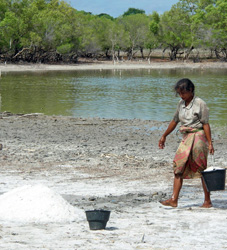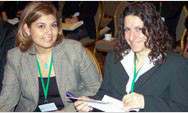You are here » Home » Telling Our Story
Success Story
Community land use offers models for land ownership policies
Tradition Informs New Land Policies

| |
Photo: Associates in Rural Development
|
|
A woman at Laga Lake, East Timor helps her community produce salt. At the end of the day, half of the salt will go to the community’s traditional chief, and the other half is split up among workers.
By custom, the salt harvest at Laga Lake belongs to descendents of local chiefs. USAID’s program analyzed local customs like this one to inform government efforts to develop a formal land ownership system.
|
One of the most complex and contentious issues in East Timor is land ownership. More than 400 years of Portuguese administration was followed by 24 years of Indonesian occupation. In 2002, the country gained full independence. The result of centuries of foreign control is a pattern of overlapping or conflicting land claims that can inhibit development and cause conflict.
A USAID-sponsored program has been working with East Timor’s government to help it develop land policies and laws to establish clear land tenure and property rights. An important step in that process was to study how land rights are exercised by communities themselves. One of these case studies involved land use near Laga, in the eastern part of the country, where traditional land tenure involves the successful exploitation of a renewable natural resource.
The Laga Lake produces hundreds of tons of salt every year from the brackish water replenished by the tides. The salt harvest belongs by custom to descendents of local chiefs, or liurai. According to the current chief, the Portuguese issued a formal title to his ancestors, and the community recognizes this claim. Each year, up to a thousand people join in the salt harvest. At the end of each day, the harvested salt is divided into two equal portions. One half goes to the traditional owner; the other half is split among the workers. Such management of the harvest helps the traditional owner and the community gain maximum yield with minimum effort.
Government recognition of such traditional systems can help formalize and improve them. With a legal basis for the system, participants have an outside forum to air grievances, and investors can identify the legally recognized representatives for negotiations and contracts. This would encourage the community and the traditional owner to manage their resource in a sustainable way and protect it for future generations.
USAID has supported the land program since 2002. By encouraging more stable and transparent land policies, USAID helps East Timor expand its private sector and build its economy.
Print-friendly version of this page (440kb - PDF)
Click here for high-res photo
Back to Top ^ | 

